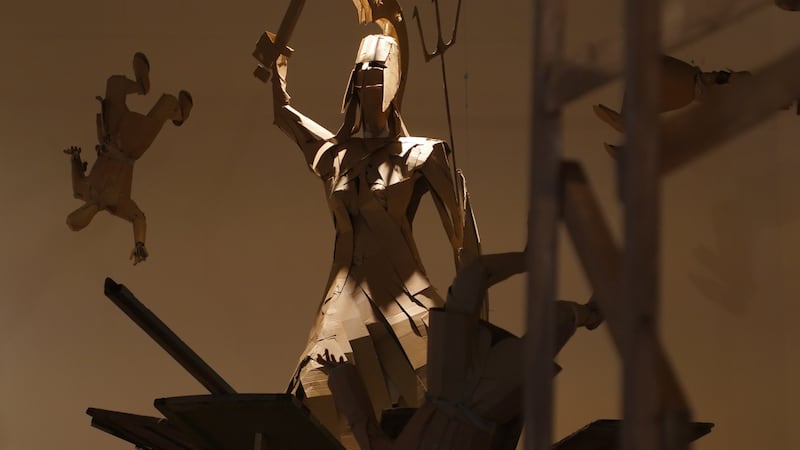The Foggy Dew – Mick O’Dea
Royal Hibernian Academy, Gallagher Gallery, Dublin
*****

The Royal Hibernian Academy on Abbey Street, Dublin, was built in 1824. It housed the academy schools and was the venue for its annual exhibition, all overseen by an elected keeper who had living quarters in the building. Following the Easter Rising in 1916, the home of the RHA was destroyed by fire during the bombardment of north Dublin. The keeper at the time, the painter Joseph Malachy Kavanagh, had to flee the burning building. He barely escaped with his life and managed to snatch his chain of office, the academy's charter and some financial documents.
That chain is, as the RHA’s 23rd president Mick O’Dea points out, the one that he now wears on official occasions.
For nearly 30 years Kavanagh had been an industrious, capable painter of the landscape in Ireland and parts of Europe. "But his studio was in the building, and essentially his life's work was lost. I think he never really recovered from that. He only survived for another two years."
Together with Kavanagh’s work, the academy also lost its entire annual exhibition, which had been on display, and many irreplaceable records, but the major loss was the destruction of the building. Although the academy managed to acquire a site in Ely Place in 1939, it was 1985 before a usable gallery came on stream, 69 years after the calamity.
Now the handsome Ely Place gallery is the venue for O'Dea's major exhibition marking the centenary of the 1916 Rising. He has called it The Foggy Dew. Four huge, four-metre canvases zero in on landmark locations. The Rising flared and faded within a tight geographical compass, he points out. In deference to his own institution, one of the locations he has chosen is the old RHA on Abbey Street.
The painting revisits the moment when Kavanagh dashed from the burning building. It is a strongly architectonic composition, as are two of its companions. The skeletal grid of the building’s facade frames the glow of the conflagration that has consumed everything within and hollowed out the interior.
The effect is even more stark in the case of the depiction of the smouldering GPO. O’Dea has opted to go for the eerie quietness of the aftermath. No combatants, indeed no people at all are visible.
In one corner of the composition a riderless horse, perhaps a nod to the symbolism of Jack B Yeats, is making its way towards O'Connell Bridge. The burnt-out feeling characteristic of this and indeed all four large canvases is enhanced by the liberal use of charcoal. Its ashy black and grey tones are knitted through washes of desaturated oil paint.
In the next composition, the tail end of a column of British troops makes its way along Dame Street leaving College Green. In the background, smoke swirls from the direction of O'Connell Street against the impervious facade of Trinity College.
Next, at the far end of O’Connell Street, British soldiers pose at the foot of the Parnell monument, which had been unveiled only in 1911. “The image comes from a postcard,” O’Dea notes. In the postcard, the monument is truncated. He restores it in his painting. The soldiers brandish an upended republican flag, and several, he noticed, carry not army-issue Lee Enfield rifles but Mausers: “Howth guns” captured as trophies.
Nothing so far would surprise those familiar with O’Dea’s ambitious series of exhibitions on the War of Independence, which concluded with his exploration of the iconography of the post-Treaty split.
Cardboard sculptures
What is surprising is the series of monumental cardboard sculptures he has made. They are dramatically lit and loom in the gallery space. Around them, bodies seem to fly through the air as though caught up in a blast. They are ambiguous presences: casualties or angels?
There are, O’Dea notes, two layers of personal retrospection wrapped up in the project. One is his return to the practice of cardboard sculpture, which he last made while in Barcelona 20 years ago. The other is his childhood recollection of the 50th anniversary commemorations of the Rising in his hometown, Ennis.
He has made a cardboard facsimile of the memorial that was unveiled in Ennis, together with a depictions of Britannia arriving with “Huns, with their long-range guns”, O’Connell with a seagull atop his head and Nelson toppling from his column.
The exaggerated theatricality of the cardboard sculptures recalls that personal moment in time. “These things were larger than life in my imagination. The gunboat that bombarded Dublin was nothing much when you compare it to a battleship or a destroyer, but it represented the might of the British empire.”
At the time the unveiling of the memorial in Ennis was a huge ceremonial event, involving many hundreds of people. "We all learned the words of The Foggy Dew, but almost at the same time as we learned the words of Yellow Submarine. I was trying to reconcile my love for British popular culture – music, football, cinema – with what I was learning from the 1916 commemoration, and a sense of distinctive Irish identity."
In The Foggy Dew, he has made a personal reflection on the Rising on an epic scale. It is spectacular, but subdued and ruminative. Despite the quashing of the Rising, the triumphalism of the British soldiers, what emerges in the muted, ominous tone of the work is that the substance and presumption of British rule was nevertheless being hollowed out.
Downstairs, before you reach the main gallery, the Rising’s leaders are acknowledged in a series of portraits, arrayed in a grid formation.
As with the exhibition as a whole, there is nothing brash or celebratory about the images. They are muted and grave. They lost the battle, but they stand for the ascendant order. Change is in the air.
- Until February 21st, rhagallery.ie











